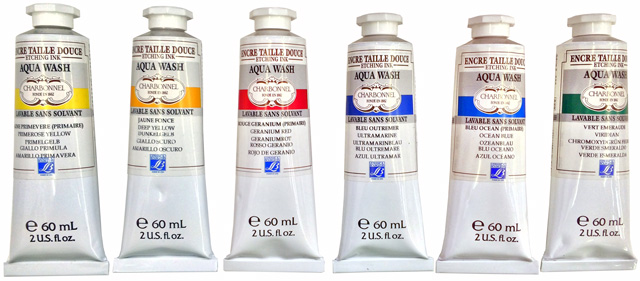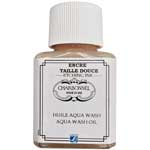Charbonnel Aqua Wash Etching Ink

- Water-washable oil-based emulsion (contains no water)
- Hands and materials can be washed with soap and water
- High pigment concentration (comparable with standard inks)
- Extremely lightfast
- All the colors can be intermixed
- Viscous and easy to wipe
- Can be used with paper that is less damp than required for standard etching ink
- Same drying times as standard inks
- Will not soften when dry
The new AP (Approved Product) Seal identifies art materials that are safe and that are certified in a toxicological evaluation by a medical expert to contain no materials in sufficient quantities to be toxic or injurious to humans, including children, or to cause acute or chronic health problems.
Color Chart
Colors
The color chart has 17 colors and 7 blacks which are familiar to the printer. These inks behave in a very similar way to standard inks with regards to hardness, suppleness, tack and viscosity.
The ink softens rapidly when blended, when fluid it adheres perfectly to all the grooves and burrs of the plates and is very easy to wipe.
- Primrose Yellow *** PY74
- Deep Yellow *** PY83
- Geranium Red *** PR48:2-PV23
- Cardinal Red *** PR112
- Vermilion Red *** PR188-PY74
- Ultramarine *** PB29
- Prussian Blue *** PB27
- Ocean Blue *** PB15:3
- Emerald Green *** PG7
- Payne's Grey *** PB29-PBk9
- Basic Bistre *** PR101-PBy6-PY7
- Sanguine *** PR101
- Raw Sepia *** PR101-PBk9-PBr7
- Warm Sepia *** PB29-PBK9-PBR7
- Yellow Ochre *** PY42
- Burnt Sienna *** PR101-PY42
- Snow White TI *** PW6
Note: Prussian blue and emerald green have a mineral pigment base and tend to bleed more easily in wet paper. These 2 colors cross the paper more easily and must be avoided when printing fine art books (bibliophily).
Blacks
Black is the most commonly used ink. This is why the etching ink color chart has 7 blacks. They are differentiated by 3 criteria:
Viscosity, tack
Viscosity determines the level of adhesion in the ink and its resistance to wiping.
Ink texture
A supple black can envelop all the surface unevenness of fine and shallow engravings. A hard, thick black will be selected to fill deep cuts and adhere to jagged edges.
Shade
Blacks can either be cold or warm depending on the pigment composition. Cold blacks (with bluish tints) should not be used for printing on slightly yellow paper. Warm blacks give deeper and more contrasting prints. The weakest black is Soft Black, it is used as a medium and mixed with some blacks whose tones are considered to be too strong, so as to soften them. Its texture is very supple. It is also used to soften some blacks, thought to be too hard, so as to make wiping easier.
- Strong and warm black
- Viscous, powerful and supple black
- Mid. black
- Very viscous, but easier to wipe than 55985: for deeply etched lines or Burin engraving
- Mid black
- Low viscosity, easy to wipe
- Warmer Black
- Low viscosity, easy to wipe
- Cold, intense black. Reinforces the other blacks
- Most viscous black, for deep etching, drypoint, burin and mezzotint
Black Luxe C (carbon)
- Slightly bluish black. Reinforces the other blacks
- Viscous, tacky and difficult to wipe
- Weak black. May be used for lowering the tones of a plate which is heavily etched (engraved)
- Very supple, low viscosity, easy to wipe
Mediums
Thick transparent medium (equivalent to Transparent White Lake in the standard range) can be mixed with any color, and increases transparency while retaining the same texture. As with the colors, this medium softens on kneading, and does not change the color with regard to its tack and its adhesion in the grooves.
 Aqua Wash Oil (equivalent to the light, oily, strong oils in the standard range) is used as a colorless thinner to render more fluid those colors that are considered to be too thick at the time of inking or wiping (the equivalent of a few drops is enough) while maintaining their viscosity. It is is also used in larger amounts (combined or not combined with water) in the monotype or photopolymer techniques, everywhere that greater fluidity is required. This oil is the binding oil of the Charbonnel Aqua Wash product range.
Aqua Wash Oil (equivalent to the light, oily, strong oils in the standard range) is used as a colorless thinner to render more fluid those colors that are considered to be too thick at the time of inking or wiping (the equivalent of a few drops is enough) while maintaining their viscosity. It is is also used in larger amounts (combined or not combined with water) in the monotype or photopolymer techniques, everywhere that greater fluidity is required. This oil is the binding oil of the Charbonnel Aqua Wash product range.
Charbonnel Color Inks Legend
★★★ Completely light fast colors, even when lightened
★★ Very light fast colors
★ Light fast colors used in a pure state
□ Transparent colors
◪ Transparent / Opaque colors
■ Opaque colors
A highly pigmented, non-toxic ink
The Charbonnel Aqua Wash range meets all the criteria for «artist» quality inks. It has a high pigmentation concentration identical to that of standard inks, and can be used in all intaglio printing techniques: such as engraving, dry-point, mezzotint, etching and aquatint, as well as monotype and relief printing techniques such as linocut and wood prints.
Art schools, and an increasing number of print workshops are now searching for water washable solutions (out of a concern for safety, the environment and owing to the toxicity of solvents, recycling issues, etc.).
Charbonnel Aqua Wash inks are genuine oily inks for use in all techniques whether etching or relief printing. They must not be confused with water and resin based inks such as gum Arabic or cellulose-tempera based inks that can be «re-softened» and are limited to monotype or relief techniques (linocut, wood engraving).
Several years of development and Quality control
Charbonnel Aqua Wash ink has been developed by the Lefranc & Bourgeois laboratory. Several years were required to establish the perfect stability of the colors and ensure the highest quality: a quality on which Charbonnel's reputation has been built.
The binder is composed of several oil emulsions. Its adhesive quality, its flexibility and its yellowing characteristics are identical to those of traditional oils. The only difference being that you can wash hands, materials and tools with... water!
Use
The 3 steps of intaglio printing are summarized below:
- Inking: ink is applied directly to a previously etched plate.
- Wiping: the surplus ink is removed from the plate, first with a lint-free cloth (tarlatan), then with the palm of the hand. Hand wiping is the only way to obtain perfectly white areas (fully wiped and free from ink).
- Printing: the inked plate goes into a manual (or electric) press, the plate is positioned against thick, dampened paper so that, under pressure, the paper (slackened through dampening) draws up ink from the smallest etched details of the plate. The only precaution to take is in adjusting the dampness of the paper.
The day before: soak the paper, let it drip dry, lay the sheets fl at in a stack under plastic, to preserve the core humidity.
The next day, before printing: let the excess water evacuate in the air by following the instructions below.
The right level of moisture is checked on the 1st print
The paper must be just damp to the touch (less damp then traditional printing) while retaining good suppleness. This adjustment is essential so that the ink does not soak through the paper and stain the blankets. There is no strict timing as it depends on the type of paper and the ambient humidity.
- The paper is too wet when the ink’s water begins to appear on the reverse side of the paper or seep straight through it.
- The paper is too dry when the deepest lines of the print are not reproduced.
As soon as the right level of paper dampness is achieved, the other sheets of the run should be isolated so that they do not continue to dry out (wrapping in plastic, for example).
For print runs
After several successive print runs, moisture is always transferred from the paper to the blankets. The blankets inevitably soak up water from the paper and releases it as the printing progresses. This problem must be anticipated when printing with water washable inks. A warning sign is given when the etching reaches a higher color value or when signs of moisture are observed on the reverse side of the print (see 1 above) In this case, it is advised to reverse or change the blankets.
Cleaning
Tools must be cleaned at each stage in the printing process: the plate, color roller, press table, work surface and naturally... your hands! Traditional oily inks that use unprocessed or boiled linseed oil are not intrinsically toxic, but cleaning the working environment involves the use of solvents (white spirit, solvent-based products, etc.) Charbonnel Aqua Wash can be cleaned using soapy water as it uses water-soluble emulsion oils. It does not contain water, so it will not rust the tools or plates (however they must be thoroughly wiped after being washed). Alcohol can effectively clean deeper etches, if necessary.
